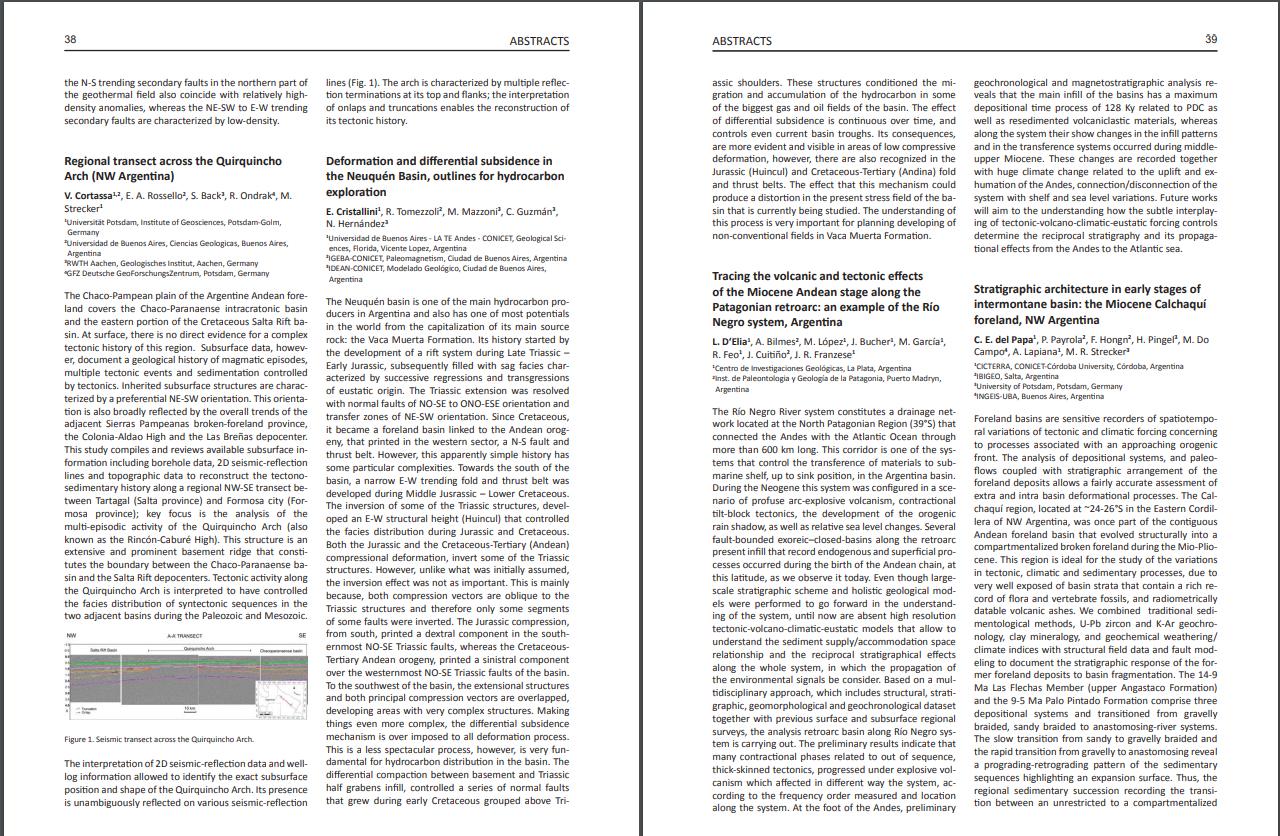Mostrar el registro sencillo del ítem
dc.contributor.author
Cristallini, Ernesto Osvaldo

dc.contributor.author
Tomezzoli, Renata Nela

dc.contributor.author
Guzman, Cecilia Griselda

dc.contributor.author
Hernandez, Natalia Marina

dc.date.available
2022-11-16T15:51:08Z
dc.date.issued
2019
dc.identifier.citation
Deformation and differential subsidence in the Neuquén Basin, outlines for hydrocarbon exploration; 25th Latin-American Colloquium of Geosciences; Hamburgo; Alemania; 2019; 1-1
dc.identifier.uri
http://hdl.handle.net/11336/178005
dc.description.abstract
The Neuquén basin is one of the main hydrocarbon producers in Argentina and also has one of most potentials in theworld from the capitalization of its main source rock: the Vaca Muerta Formation. Its history started by thedevelopment of a rift system during Late Triassic ? Early Jurassic, subsequently filled with sag facies characterized bysuccessive regressions and transgressions of eustatic origin. The Triassic extension was resolved with normal faults ofNO-SE to ONO-ESE orientation and transfer zones of NE-SW orientation. Since Cretaceous, it became a forelandbasin linked to the Andean orogeny, that printed in the western sector, a N-S fault and thrust belt. However, thisapparently simple history has some particular complexities. Towards the south of the basin, a narrow E-W trendingfold and thrust belt was developed during Middle Jusrassic ? Lower Cretaceous. The inversion of some of theTriassic structures, developed an E-W structural height (Huincul) that controlled the facies distribution during Jurassicand Cretaceous. Both the Jurassic and the Cretaceous-Tertiary (Andean) compressional deformation, invert some ofthe Triassic structures. However, unlike what was initially assumed, the inversion effect was not as important. This ismainly because, both compression vectors are oblique to the Triassic structures and therefore only some segments ofsome faults were inverted. The Jurassic compression, from south, printed a dextral component in the southernmostNO-SE Triassic faults, whereas the Cretaceous-Tertiary Andean orogeny, printed a sinistral component over thewesternmost NO-SE Triassic faults of the basin. To the southwest of the basin, the extensional structures and bothprincipal compression vectors are overlapped, developing areas with very complex structures. Making things evenmore complex, the differential subsidence mechanism is over imposed to all deformation process. This is a lessspectacular process, however, is very fundamental for hydrocarbon distribution in the basin. The differentialcompaction between basement and Triassic half grabens infill, controlled a series of normal faults that grew duringearly Cretaceous grouped above Triassic shoulders. These structures conditioned the migration and accumulation ofthe hydrocarbon in some of the biggest gas and oil fields of the basin. The effect of differential subsidence iscontinuous over time, and controls even current basin troughs. Its consequences, are more evident and visible inareas of low compressive deformation, however, there are also recognized in the Jurassic (Huincul) and CretaceousTertiary (Andina) fold and thrust belts. The effect that this mechanism could produce a distortion in the present stressfield of the basin that is currently being studied. The understanding of this process is very important for planningdeveloping of non-conventional fields in Vaca Muerta Formation.
dc.format
application/pdf
dc.language.iso
eng
dc.publisher
Universität Hamburg
dc.rights
info:eu-repo/semantics/openAccess
dc.rights.uri
https://creativecommons.org/licenses/by-nc-sa/2.5/ar/
dc.subject
differential subsidence
dc.subject
Neuquen Basin
dc.subject
hydrocarbon exploration
dc.subject
deformation
dc.subject.classification
Geología

dc.subject.classification
Ciencias de la Tierra y relacionadas con el Medio Ambiente

dc.subject.classification
CIENCIAS NATURALES Y EXACTAS

dc.title
Deformation and differential subsidence in the Neuquén Basin, outlines for hydrocarbon exploration
dc.type
info:eu-repo/semantics/publishedVersion
dc.type
info:eu-repo/semantics/conferenceObject
dc.type
info:ar-repo/semantics/documento de conferencia
dc.date.updated
2022-11-09T18:45:12Z
dc.journal.pagination
1-1
dc.journal.pais
Alemania

dc.journal.ciudad
Hamburgo
dc.description.fil
Fil: Cristallini, Ernesto Osvaldo. Consejo Nacional de Investigaciones Científicas y Técnicas. Oficina de Coordinación Administrativa Ciudad Universitaria. Instituto de Estudios Andinos "Don Pablo Groeber". Universidad de Buenos Aires. Facultad de Ciencias Exactas y Naturales. Instituto de Estudios Andinos "Don Pablo Groeber"; Argentina
dc.description.fil
Fil: Tomezzoli, Renata Nela. Consejo Nacional de Investigaciones Científicas y Técnicas. Oficina de Coordinación Administrativa Ciudad Universitaria. Instituto de Ecología, Genética y Evolución de Buenos Aires. Universidad de Buenos Aires. Facultad de Ciencias Exactas y Naturales. Instituto de Ecología, Genética y Evolución de Buenos Aires; Argentina
dc.description.fil
Fil: Guzman, Cecilia Griselda. Consejo Nacional de Investigaciones Científicas y Técnicas. Oficina de Coordinación Administrativa Ciudad Universitaria. Instituto de Estudios Andinos "Don Pablo Groeber". Universidad de Buenos Aires. Facultad de Ciencias Exactas y Naturales. Instituto de Estudios Andinos "Don Pablo Groeber"; Argentina
dc.description.fil
Fil: Hernandez, Natalia Marina. Consejo Nacional de Investigaciones Científicas y Técnicas. Oficina de Coordinación Administrativa Ciudad Universitaria. Instituto de Estudios Andinos "Don Pablo Groeber". Universidad de Buenos Aires. Facultad de Ciencias Exactas y Naturales. Instituto de Estudios Andinos "Don Pablo Groeber"; Argentina
dc.relation.alternativeid
info:eu-repo/semantics/altIdentifier/url/https://e-docs.geo-leo.de/handle/11858/7935?locale-attribute=en
dc.conicet.rol
Autor

dc.conicet.rol
Autor

dc.conicet.rol
Autor

dc.conicet.rol
Autor

dc.coverage
Internacional
dc.type.subtype
Otro
dc.description.nombreEvento
25th Latin-American Colloquium of Geosciences
dc.date.evento
2019-09-18
dc.description.ciudadEvento
Hamburgo
dc.description.paisEvento
Alemania

dc.type.publicacion
Book
dc.description.institucionOrganizadora
Universität Hamburg
dc.source.libro
25th Latin-American Colloquium of Geoscience: Program and Abstracts
dc.date.eventoHasta
2019-09-21
dc.type
Otro
Archivos asociados
